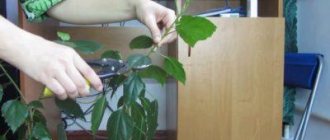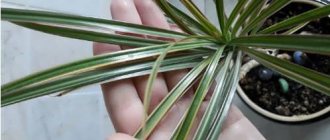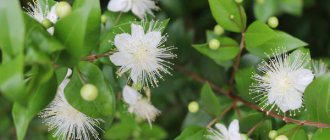All types of dracaenas are ideal plants for home keeping . They are able to grow both on bright south-eastern window sills and in the back of the room under artificial light. They also have no special requirements for soil composition and room humidity.
Most species of these palms grow very tall in nature. As they grow, the lower leaves age and fall off, the stem gradually becomes bare and the plant loses its decorative appearance. Therefore, pruning of dracaena is necessary to obtain side shoots.
What types of dracaena need to be pruned?
Among the variety of dracaenas, there are varieties that require regular pruning. These are the varieties Reflexa, Surculose, and Fragrant.
Dracaena Reflexa
In nature, it is a huge tree up to 10 m tall. In home floriculture, it is grown as a bush up to 1 m in height. The plant has brightly colored, pointed leaves, up to 20 cm, and thick, powerful stems. Foliage color ranges from dark to light shades of green, with beige or yellow stripes.
Dracaena Surculosa (Surculosa)
New shoots grow out of the ground. In room conditions it reaches a height of 1.5 meters. This species grows well in width, and the number of shoots in the pot increases quickly. The leaves are oval, with a pointed edge.
Several subspecies of this dracaena have different foliage colors. Juicy bright green leaves are covered with yellow, white, cream or light green spots of different diameters.
Dracaena fragrant (Fragrans)
In nature it reaches a height of six meters. At home it grows up to 1.5–2 meters . Bright, glossy leaves 60 cm long tightly cover the erect stem. The color of the leaves is plain, dark green or with light stripes.
Trimming time
When can you prune dracaena?
Favorable time for pruning is April and May . This is a period of active growth during which sap flow begins. During these months, phytohormones are actively produced: cytokinins and auxins, which contribute to the rapid growth of lateral shoots. The wound after pruning in the spring will quickly heal.
Is it possible to prune dracaena in winter and summer?
In the summer and winter months it is not recommended to form a crown. These are periods of rest when all processes in the plant slow down. New buds may not appear for a long time after pruning and the wound on the cut will take a long time to heal. Pruning during this period is a lot of stress for the flower .
ATTENTION! Winter pruning is allowed in emergency cases when the stem of the plant is broken.
Methods and rules for crown formation
To form the crown of dracaenas, there are two pruning methods.
Sanitary and preventive pruning
With this method, diseased, damaged leaves and shoots are removed.
Most flower diseases appear due to improper care : overwatering, dry air, drafts.
This is immediately reflected in the leaves, which begin to turn yellow, dry out and fall off.
The stem quickly becomes bare and the plant becomes unattractive. Therefore, ten days after treating the flower with fungicides, it is possible to prune.
The purpose of pruning is to prevent further spread of the disease and remove damaged leaves and shoots.
Decorative pruning
Aimed at forming dracaena of a beautiful shape, with leafy shoots.
How to understand that you need to pinch the top to get side shoots:
- the plant has grown almost to the ceiling and has become too tall, making it difficult to care for;
- shoots become deformed and take on an ugly shape;
- the plant has only one trunk, which is bare and looks unattractive.
- the plant must be healthy , free from pests;
- Do not combine replanting and pruning the plant ; the interval between these procedures is up to two months.
How to prune dracaena correctly:
Items needed for pruning:
- sphagnum moss - has a loose structure, is able to absorb and retain moisture;
- garden varnish - will protect the wound from leakage of juice and from infection;
- sharp pruning shears or knife - to obtain an even cut.
When should the procedure be performed?
It is better to do the operation in the spring, no matter what the purpose of pruning:
- formation of dracaena;
- obtaining cuttings for propagation;
- increased branching;
- shortening a tall trunk;
- rejuvenation.
At the beginning of the growing season, growth and regeneration processes are especially intense. The wounds heal quickly, and the dormant buds closest to the pruning site are guaranteed to wake up.
A flower can produce 2-5 new sprouts at once. But some usually dry out, only in the spring can all of them survive, and only with careful care.
In the summer, the cut stem of the buds awakens well, but they often dry out, often only one remains, and this is already ugly. The plant will be shorter, but without a fork.
During the dormant period, the renewed shoot can stand until spring with swollen buds that look like a small horn. How many of them will open with the start of sap flow is unknown. Perhaps everything will dry out, and then what is the point in late pruning?
Often the operation is associated with culture propagation. Apical cuttings or pieces of stems produce roots no worse than layering; there is no point in resorting to such a labor-intensive method. It is also better to plant plants in the spring.
An exception is pruning dying specimens:
- If the dracaena is overwatered and the root begins to rot, the load on the above-ground part must be reduced. Even when the flower has not grown much, it looks beautiful; it is better to remove the top with leaves. All energy will be spent on regenerating the roots, rather than providing power and water to the outlet.
- When the stem has softened, the dracaena needs to be urgently saved, regardless of the season, so that rotting does not spread to healthy tissue. The affected area is removed, the cut apical cutting is rooted.
Step-by-step instructions for crown formation
How to prune dracaena at home without harming the plant? Let's consider the main stages of how to form a crown:
- Determine the cutting height. Make a mark on the trunk where young shoots should appear.
- Make an even cut with a quick movement. Use sharp pruning shears or a knife. Do not break off the top.
- Juice will be released from the cut site, which must be removed with a piece of cotton wool. Then treat the cut area with melted garden varnish. Do not use it very hot, so as not to burn the plant.
- Remove leaves on the remaining shoot 15 cm below the cutting level.
- Spray the trunk with water. During pruning, the plant loses a lot of moisture necessary for normal development.
- Wrap the trunk where the leaves were removed with sphagnum moss and carefully secure it with thread. Regularly moisturize this area and prevent it from drying out.
- Moisten the soil by watering through a tray.
- Before the side shoots appear, place a transparent bag on the shortened part of the plant. It will create a greenhouse effect, increase humidity in the pruning area and promote the appearance of buds. Once every five days, remove the bag for ventilation to prevent the formation of a fungal infection.
- Move the pot with the plant from a sunny windowsill to a dark place with a high temperature.
You can also cover the cut area with polyethylene, as shown in this video, then you will not have to constantly moisten this area:
ADVICE! It is advisable to trim the stems at different heights. As the side shoots grow, tufts of greenery will form along the entire length of the plant. The bush will look voluminous and fluffy.
How to grow a lot of tops and make dracaena fluffy
Dracaena is a plant that has won the hearts of gardeners with its undemanding care.
Dracaena will decorate any interior. For the normal growth of this flower, you just need to follow these recommendations:
- Make sure the soil is sufficiently dry before watering. To do this, the soil is loosened. If the soil is wet at a depth of three centimeters, then it is better to refrain from watering.
- Those varieties of dracaena with wide leaves drink more water than those with narrow foliage.
- A flower with variegated leaves will grow well if placed on a window on the south side of the apartment.
- Dracaena does not tolerate drafts, scorching sun and accumulation of dust on the surface of the foliage.
- Transplanting from pot to pot should be done together with old soil so as not to damage the root system.
Initially the flower grows into one trunk and it is a little sad. Therefore, some gardeners make the crown fluffy. Before forming a dracaena, the trunk must grow at least thirty centimeters. The trunk must have a diameter of at least five centimeters.
Ten centimeters of the upper part of the flower are cut off. After pruning the dracaena for branching, two or even five new shoots may appear on the trunk. It is recommended to leave the three strongest shoots so that the plant can develop normally and not get sick.
The most popular varieties are:
Caring for dracaena after pruning
After pruning the dracaena, it is advisable to create comfortable conditions:
- A month after pruning, the dracaena should have new side shoots. During this period, remove the greenhouse from the flower and move the pot to a permanent place.
- Room humidity - 75%; air temperature - up to 25 °
- Lighting. Ensure a uniform supply of diffused sunlight.
- Periodically turn the pot with the plant so that the shoots do not reach towards the light and develop evenly.
- Make sure the soil is constantly moist, but do not allow it to overflow.
- Spray the crown once a day with settled or filtered water.
- A stream of water is a fine spray that will evenly moisten the entire surface of the sheet. Once a week add “Epin” or “Zircon” to stimulate the growth of new shoots.
IMPORTANT! Make sure that water does not get into the rosettes of leaves during sprinkling. This will protect the plant from trunk rot.
Dracaena tolerates pruning well and allows the formation of a fluffy crown. With the help of simple pruning, the aesthetic appearance is easily maintained and a beautiful plant shape is formed.
What to do with the tops?
Thanks to rejuvenation, you can get strong and healthy plants - to replace old ones, as a gift, planted in a group or to expand your collection. Of course, if the goal is to stimulate branching and renew the old dracaena, it is not necessary to root the tops. But it’s unlikely that anyone would raise their hand to throw away the beautiful, lush cut top, especially since it takes root very easily. If desired, you can root not only the tops, but also parts of the trunk with at least several internodes.
With proper trimming, a sharp, even cut without jagged edges remains the same, but if something goes wrong, it can be renewed. Before rooting, the cuts need to be dried, if possible, treated with a special paste for wounds or at least sprinkled with crushed coal.
In order for the tops of the dracaena to take root, it is enough to place them in damp sand, a sand-peat mixture or a universal substrate. Stem cuttings can be laid on the soil, slightly pressed, or rooted as tops.
For dracaena cuttings, you need to maintain stable, light soil moisture, continuing to water as the top layer of soil dries. Many people root dracaena simply in water, but in this case you will have to remember to change the water regularly, every few days.
After trimming the dracaena, you can root not only the tops, but also parts of the trunk. © 1885house











